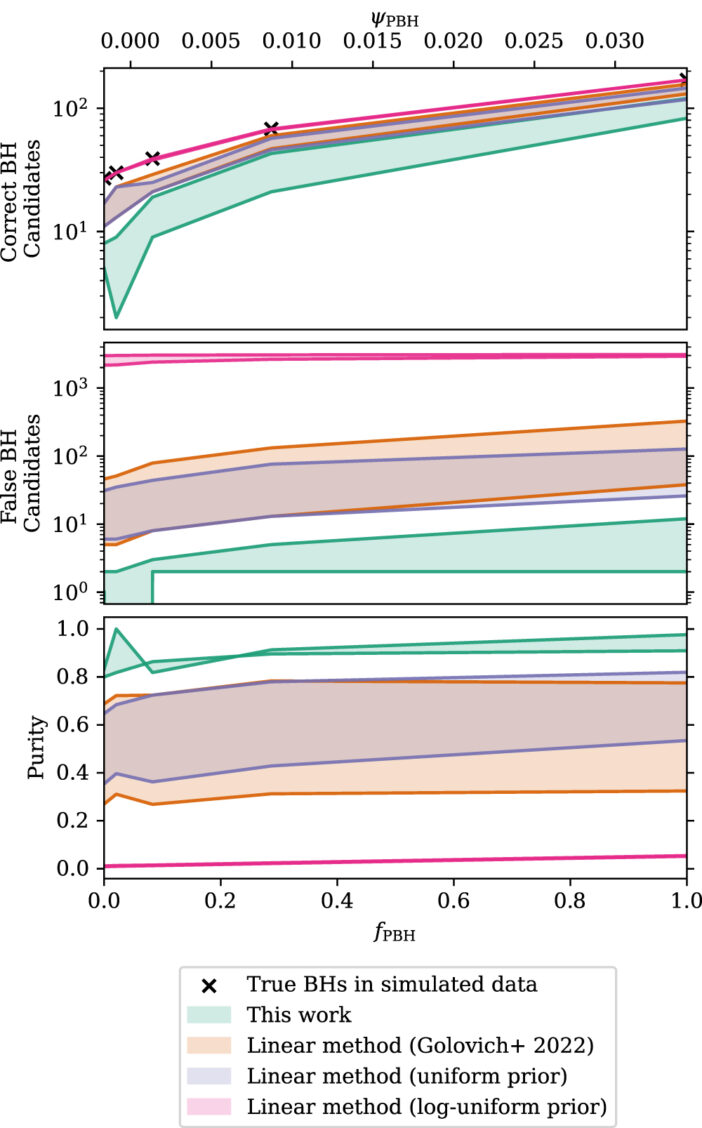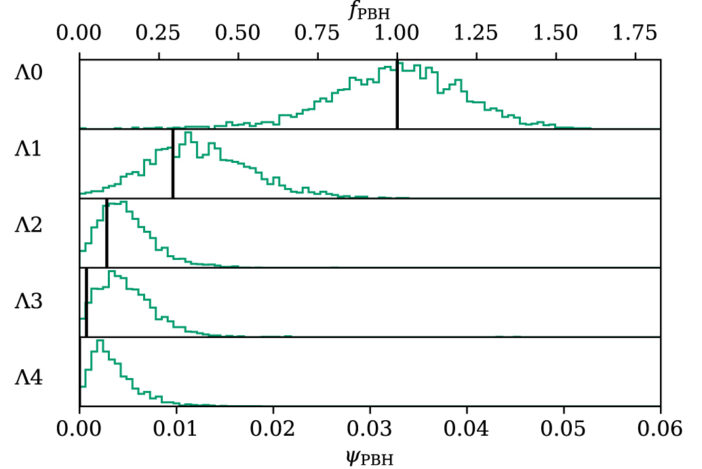Editor’s Note: Astrobites is a graduate-student-run organization that digests astrophysical literature for undergraduate students. As part of the partnership between the AAS and astrobites, we occasionally repost astrobites content here at AAS Nova. We hope you enjoy this post from astrobites; the original can be viewed at astrobites.org.
Title: Disentangling the Black Hole Mass Spectrum with Photometric Microlensing Surveys
Authors: Scott Ellis Perkins et al.
First Author’s Institution: Lawrence Livermore National Laboratory
Status: Published in ApJ
Lonesome Black Holes
Seeing the darkness is something that is a great mystery in modern physics, from dark matter to black holes. How do you see something that doesn’t emit light?
Current methods of detecting black holes include observing their accretion from surrounding matter, whether that’s supermassive black holes in the centres of galaxies or smaller black holes that are stealing matter from a stellar companion. Black holes that don’t have any glowing surrounding matter may have a black hole or neutron star partner to spiral into, releasing gravitational waves that we detect with the LIGO, Virgo, and KAGRA detectors. But lonely black holes sitting in the darkness are significantly harder to uncover. In the Milky Way, it’s expected that there are 100 million isolated and binary black holes that are born from dead massive stars. Of those, only ~50 have been detected.
Twinkling Lights
Fortunately, there’s a detection method that can fill this gap: microlensing. If an isolated black hole is located in front of a star or galaxy much farther away, that background object’s brightness will vary with time as its light is lensed by the black hole moving in front of it (see Figure 1). This is similar to a magnifying glass passing in front of the star’s tiny pinprick of light, but instead the lens of the glass is the curvature of spacetime due to the mass of the black hole. Because the lens magnifies the background object, it will appear to change in brightness, twinkling like fairy lights.
Figure 1: An animation of a black hole passing in front of a background star. Because the black hole bends spacetime along the path from the star to the observer, two images of the star are created. The lensing also changes the apparent brightness of the star, which is still detectable photometrically even when the different images are too close to be separately resolved by the observer. [NASA’s Goddard Space Flight Center Conceptual Image Lab]
However, there are a few different kinds of objects that can lens background stars. Black holes, white dwarfs, neutron stars, and free-floating planets have all been found through microlensing. If we can know the mass of the lens, then we can characterise a lens as a stellar-mass black hole (usually 5–100 times the mass of the Sun). However, an individual microlensing light curve doesn’t carry any useful information about the mass of the lens without also knowing the astrometric shift in the lensed object — something we don’t have for many microlensing observations. However, studying a larger group of microlensing events can break the degeneracies present in individual light curves, helping researchers classify lensing events and search for the hidden black holes in the dark. Today’s article defines a framework for determining the class of individual detections and groups of microlensing events using probabilistic models and Bayesian statistics.
Looking at Populations of Black Hole Lenses
Different types of lenses will be distributed differently in the effects they create in the light curves that we detect. For example, there will be more black holes over a certain range of masses and more white dwarfs over a different range of masses. This means that the distributions of some of the measurements of the lensing profile, such as the angle between the image of the source and the actual source location, will be different because of correlations between these parameters and the lens mass.
This article looks at three kinds of lenses: free-floating planets, stellar-mass black holes, and primordial black holes. Accounting for primordial black holes in the model separately from stellar-mass black holes allows this method to demonstrate a measure of the abundance of primordial black holes, which could provide an explanation for dark matter or evidence for the first black hole seeds in the early universe. The authors construct five simulated universes with the same number of mock microlensing events for free-floating planets and stellar-mass black holes, but each with a different number of primordial black holes. For each of these universes, the distribution of the distances and the kinematics of the events are the same, but there is a different distribution of lens masses caused by the varying fraction of primordial black holes.
Using these mock events, the authors construct a probability distribution for events belonging to a certain class for each universe. If you assume a fixed group of certain types of lenses (meaning a fixed mock universe and lens mass distribution), and you know the profiles of the microlensing light curves that are likely to be produced by each of those different lens types, you can say how probable it is that a microlensing event is caused by a specific type of object. Their method reliably classifies most of the true black hole events from each population’s mock events, as shown in Figure 2. While their method has fewer correct black hole candidates, or “true positives,” than previous methods, their identified population of black holes has many fewer false black hole identifications and therefore a much higher purity of detection.

Figure 2: The number of mock microlensing events correctly categorised as black holes (top panel), incorrectly categorised as black holes (e.g., these were simulated free-floating planets but appeared to be black holes in their framework; middle panel), and the fraction of correctly identified black holes divided by the total number of black hole identifications (bottom panel), versus the fraction of primordial black holes in each population. This method is shown in the green band, while previous methods are shown in orange, purple and pink. The bottom edge of each band represents the number for which the classification probability is above a 50% confidence, while the upper edge is 90% confidence. While this method does not reach the true number of correctly identified black hole events (black crosses), it does have the highest purity of all methods. [Perkins et al. 2024]

Figure 3: The predicted values for the fraction of primordial black holes (fPBH) with the authors’ framework (green), for five simulated universes (Λ 0-4). The true value is marked with the black vertical line for each universe. The predicted fraction follows the true fraction well, and the width of this distribution represents the uncertainty determined by the framework. [Adapted from Perkins et al. 2024]
The Future of Black Hole Microlensing Surveys
The next step for the authors’ statistical framework is to test it with real photometric measurements of microlensing from the Optical Gravitational Lensing Experiment (OGLE), a survey of more than a billion stars for time-domain astrophysics. By combining this method and real observations with more realistic model universes and more sophisticated simulations of primordial black holes, stellar-mass black holes, and other types of lenses, this could tell us more about the population of stellar-mass black holes alone in the wild. Pairing these results up with astrometric measurements that will come from the Nancy Grace Roman Space Telescope in the next few years will provide even more knowledge about the kinds of black holes making stars (or fairy lights?!) twinkle in the night sky.
Original astrobite edited by Samantha Wong.
About the author, Storm Colloms:
Storm is a postgraduate researcher at the University of Glasgow, Scotland. They work on understanding populations of binary black holes and neutron stars from the gravitational wave signals emitted when they merge, and what that tells us about the lives and deaths of massive stars. Outwith astrophysics they spend their time taking digital and film photos and making fun doodles of their research.
